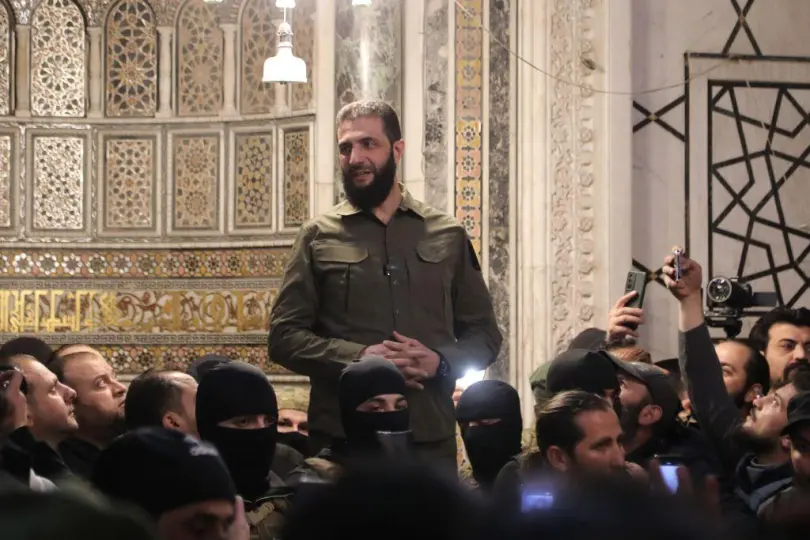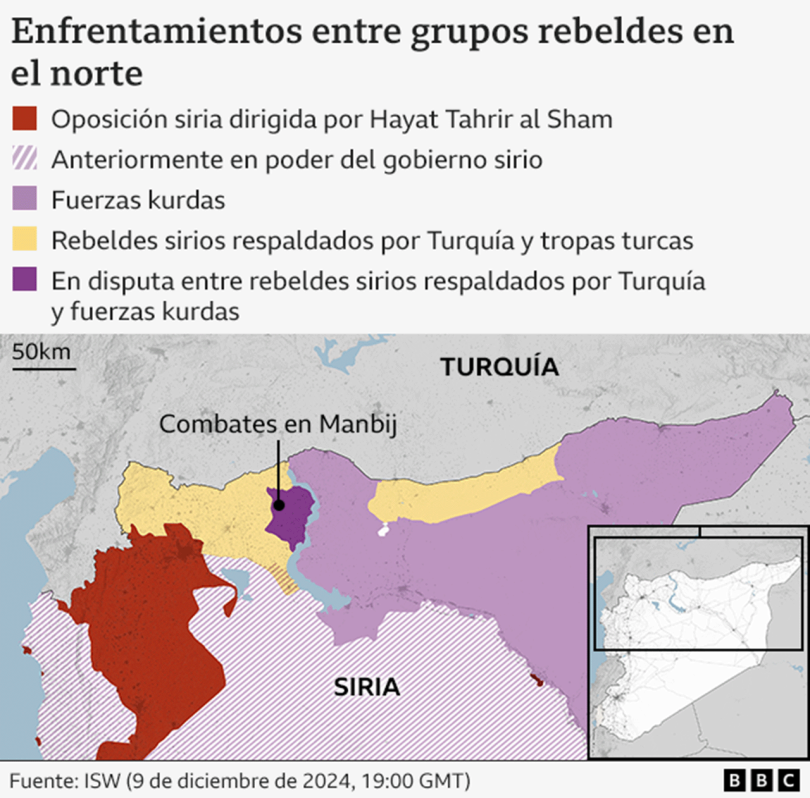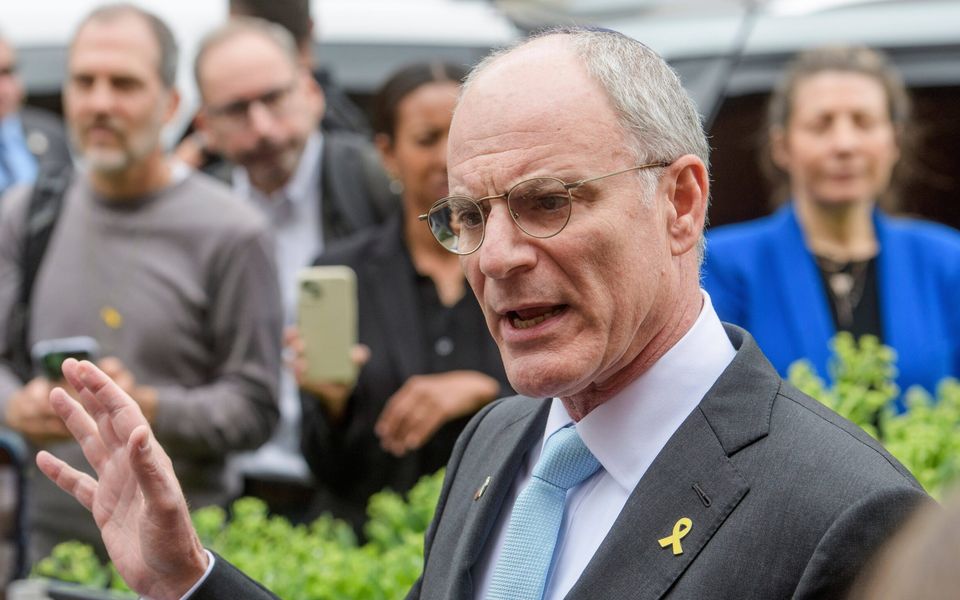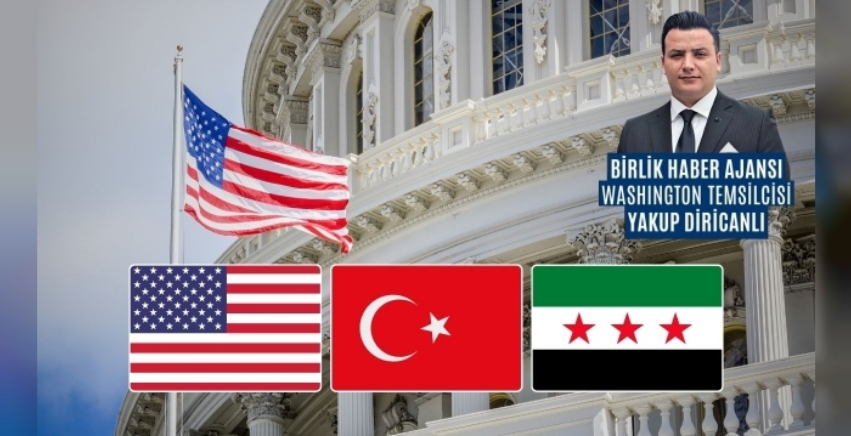Maps that show how the different rebel groups operating in Syria divide the territory
The fall of Bashar al Assad’s regime has left a power vacuum in Syria.
The various rebel groups that have disputed control of the country since the civil war began more than 13 years ago must now begin a complex transition and form a new government.
Until now, they were united by the goal of defeating a bloody regime that had been in power for half a century.
But their ideologies and political ambitions, in addition to their international patrons, are very different, which is why, once Assad is overthrown, this transitional period becomes complicated.
Three main militias –Hayat Tahrir al Shar (HTS), the Syrian National Army (ENS) and Syrian Democratic Forces (FDS), which in turn act as an umbrella for other smaller groups – operate in Syria, where they control large parts of the territory.
Added to this is a swarm of small local formations in different parts of the country, especially in the south, and the remains of the jihadists of the Islamic State group, still latent in some desert areas of the country.
The territory that was controlled by Al Assad’s troops is now in dispute, as well as certain points of friction where these militias fight among themselves for control.
The division of the country began in 2011 when a peaceful uprising against Syrian President Bashar al Assad turned into a full-scale civil war.
The conflict has left half a million dead and has become a subsidiary war in which until now countries in the region, Russia and the United States have participated.
Control of each part of Syria has changed significantly since the start of the war.

President Al Assad’s government initially lost vast territories to rebel forces, but starting in 2015 it managed to gain support from Russia and regained control of around two-thirds of the country. Iran’s support was also essential.
In the north, where Syria borders Türkiye, there are numerous borders drawn by self-proclaimed authorities or armed groups backed by international actors.
From east of the capital, Damascus, to the lands reaching the Euphrates River, the territory was under Iranian influence, according to Serhat Erkmen of the Center for Risk and Security Analysis.
And the Mediterranean coast up to Damascus and the southern lands were under the influence of Russia, he added.
All of this territory, which was controlled by the Syrian army, has now been left in a kind of limbo and could become an object of dispute by the militias operating in the country.
We explain here which are the main Syrian armed groups and what territories they control.
Hayat Tahrir al Sham
In northwest Syria lies Idlib province, which has been controlled by several rival opposition factions since government forces lost control of that province in 2015.
Now It is largely under the power of Hayat Tahrir al Sham (HTS, Organization for the Liberation of the Levant).
This is the group that has led the offensive against Al Assad that managed to overthrow him in just two weeks.
Their uprising and rapid advance towards Damascus, taking the cities of Aleppo, Hama and finally Homs along the way, gave rise to other groups to seize the opportunity and march towards the capital from the south.
HTS has taken over the entire strip from Idlib to Damascus, which is now under its control, and has reached the Mediterranean coast as far as Latakia, in the north, and the strip that borders Lebanon.
It has also taken control of some points on the Euphrates, such as the city of Deir Ezzor, which was dominated by regime troops, but which the Kurds invaded last week and which has now changed hands again.
The leader of HTS is Ahmed al Sharaa, known until now by his nom de guerre Abu Mohammed al Julani, who has played a leading role in this lightning rebellion.
“(HTS) used to be called Nusra Front and many people will be familiar with that name. It was the branch of al Qaeda in Syria,” explains Mina al Lami, a specialist in jihadist media at BBC Monitoring.

In 2016, the al Nusra Front announced that it was severing its ties with al Qaeda, as local rebel groups refused to work with them due to the al Qaeda brand.
“Everyone was afraid of al Qaeda. For this reason, the group announced its independence,” says Mina al Lami.
Although HTS insists it is independent and not linked to an outside entity, and claims it has no global jihadist ambitions, the UN, US and Türkiye They consider it a group still associated with al Qaeda and include it on the list of terrorist organizations.
Syrian journalist Sarkis Kassargian says there are many radical groups supporting HTS in the region, such as the Turkestan Islamic Party, a jihadist group dominated by Chinese Uyghurs.
After forcing most Turkish-backed militants out of Idlib, HTS established a de facto administrative authority in the region, known as Syrian National Salvation Government.
This authority, which presented itself as a “small State within the State” and sought to obtain the approval of the international community, had ministries and ministers very active on social networks, who inaugurated projects, focused on reconstruction and attended graduations, as Mina al Lami explains.
After the capture of Damascus and the overthrow of the Al Assad regime, this National Salvation Government has been transformed into the new Syrian transitional government.
Mohamed al Bashir, who led that administrative authority established by HTS in Idlib, has now become the interim prime minister of the transitional government.
Syrian Democratic Forces
Another prominent group in the northeast of the country They are the Syrian Democratic Forces (SDF).
This coalition of ethnic Kurdish and Arab militias and rebel groups controls extensive areas from east of the Euphrates River to the Iraqi border.
bz=1&psd=W251bGwsbnVsbCxudWxsLDNd&ifi=9&uci=a!9&btvi=10&fsb=1&dtd=M
It feeds mainly on the People’s Protection Units (YPG), a Kurdish militant group backed by the United States, and one of its main partners in Syria in its fight against the jihadists of the Islamic State.
Kurds make up around 10% of Syria’s population, and the Syrian Democratic Forces maintain close economic, political and military cooperation with the US.
In 2018, the FDS unilaterally declared an entity under the name of Autonomous Administration of North and East Syriaanother state within a state that controls a quarter of Syrian territory and hosts US and Russian military bases.
In this territory are the internment camps for relatives of the Islamic State group, such as Al Hol, where some 60,000 women and children live in poverty, who are guarded by the FDS with the support of US troops.
Throughout these years, the SDF, unlike other opposition groups, has tried to establish “international legitimacy using both channels, through Moscow and Washington,” explains security analyst Serhat Erkmen.
They have also held talks with the Syrian government in the past to determine how they could integrate into the country’s future.
In addition to the Islamic State, which the SDF fought hard and managed to seize important cities in the northeast, the Kurdish forces also have an enemy in Türkiye.
The two have been fighting over control of Manbij, a city in northeastern Syria near the Arab-majority Turkish border.
However, after the fall of Al Assad, the US and Türkiye have reached an agreement so that Kurdish troops can safely withdraw from Manbij.

The presence of the SDF on the Turkish border is one of Ankara’s main concerns.
The Kurdish people are mainly divided between Syria, Iraq, Iran and large areas of eastern Türkiye.
There Ankara fights a battle lasting more than three decades against the militant group PKK (Kurdistan Workers’ Party), which Türkiye considers terrorist.
Therefore, northern Syria is of vital importance for Ankara.
Syrian National Army
Turkish concern over its southern border has led it to support a series of Syrian militant groups operating in the north of the country under the umbrella of what it called the Syrian National Army (SNA) in 2017.
This coalition incorporated many members of the Free Syrian Army (FSA), the first that was created in 2011 by defecting army officers to fight against Bashar al Assad’s regime and protect opposition protesters.
The ENS is also made up of groups directly linked to the Turkish military or that country’s intelligence, such as the Sultan Murad Division, and other groups with affiliations to the Muslim Brotherhood and Qatar.
But among its members there are also mercenaries without ideology, who joined some of the formations to receive a salary from Türkiye.
“As far as we know, these groups do not work alongside jihadist groups, but they are of course in line with Turkey’s own agenda, priorities and ambitions in the region,” notes BBC Monitoring’s Mina al Lami.
That is why, in addition to fighting the Syrian army to its collapse this week, they are also fighting the Kurdish-led Syrian Democratic Forces.
With the support of Türkiye, The ENS today controls areas from Afrin to Jarablus, in the west of the Euphrates River, and from Tell Abyad to Ras al Ayn in the east.
On November 30, they launched an operation against Kurdish forces in northern Aleppo, making gains and taking control of areas such as the town of Tell Rifaat, previously controlled by the Kurds.
The ENS is part of the administrative authority called the Syrian Provisional Government, and the Turkish government and military also play an important role in the region.
Turkey hosts some 3 million Syrian refugees, whom it wants to return to their country in some way, and has seen in this northern area of Syria not only a buffer area from possible Kurdish attacks, but also a territory in which to relocate. to the refugees.
Islamic State and other groups
The group calling itself the Islamic State (IS), also known as ISIS or Daesh in Arabic, proclaimed its caliphate in 2014 and for years managed to seize vast sections of Syria and Iraq.
The emergence of IS changed the course of the war in Syria and prompted the formation of a US-led coalition that included more than 70 nations to defeat it.
In 2019, that coalition finally expelled IS from its last refuge in Syria.
But has the IS threat in Syria completely ended?
The group’s activity was beginning to pick up and, in the last year, its attacks have increased significantly, according to Mina al Lami.
The great fear is that its militiamen will manage to free fighters and their families held in several camps controlled by the FDS, which some observers have described as incubators. of jihadists.
Amnesty International assures that, more than five years after the defeat of IS, tens of thousands of people are still detained: some 11,500 men, 14,500 women and 30,000 children are held in at least 27 detention centers and two confinement camps: Al Hol and Red.
“Islamic State has its eyes on those fields. It is waiting for any crisis, any weakening of security to be able to enter and assault those camps and prisons and free the people who are there“says Mina al Lami.
Since last weekend, the United States has carried out several bombings of Islamic State positions to prevent the jihadists from taking advantage of the collapse of the Syrian army and the power vacuum to secure territory.
“We will not let this happen,” announced US President Joe Biden in a televised speech from the White House after the fall of Al Assad.
The US has about 900 soldiers in Syria and a military base, Al Tanf, on the southeastern border with Iraq.
Among the many smaller and local armed groups that have emerged in these 13 years of war, a new coalition stands out in the south, known as Southern Operations Room (SOR, for its acronym in English).
The SOR, which operated with insurgents on the outskirts of Damascus, was among the first alliances to arrive in the Syrian capital over the weekend.
It is made up of Druze militias and other opposition groups, and is also supported by militiamen from the Free Syrian Army.


